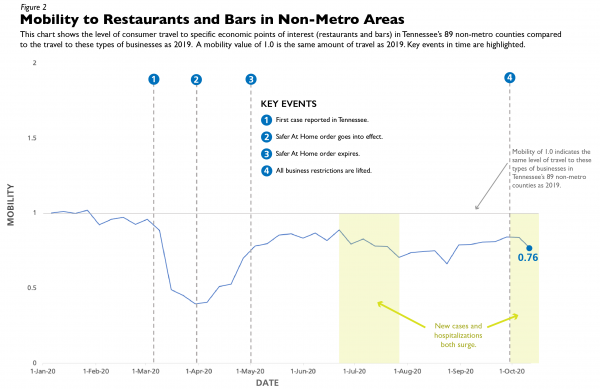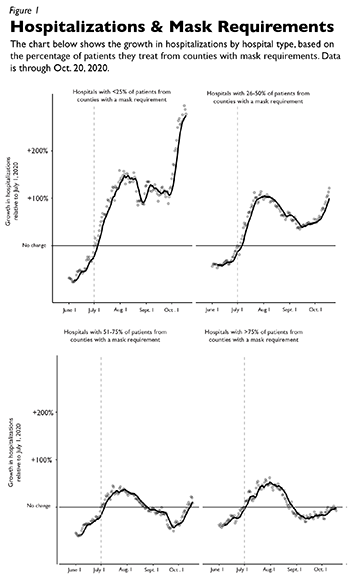 All areas of Tennessee have seen a resurgence in hospitalized COVID-19 patients since early October, but hospitals that draw patients from counties without masking requirements are experiencing much sharper increases, according to a new analysis from researchers at Vanderbilt University Medical Center and Vanderbilt University School of Medicine.
All areas of Tennessee have seen a resurgence in hospitalized COVID-19 patients since early October, but hospitals that draw patients from counties without masking requirements are experiencing much sharper increases, according to a new analysis from researchers at Vanderbilt University Medical Center and Vanderbilt University School of Medicine.
The analysis updates a previous report and comes as hospitalizations and new cases of COVID-19 have reached their highest points to date. The analysis, led by the Vanderbilt Center for Health Economic Modeling, also updates analyses done earlier this year on consumer mobility to specific types of business and consumer spending in specific industries.
“We’ve seen a statewide increase in hospitalizations since early October, indicating that masking alone is not sufficient to curb further spread of the virus,” according to John Graves, Ph.D., director of the center and associate professor of Health Policy at Vanderbilt. “But it’s very clear that areas where masking requirements have remained in place have seen much lower growth in COVID-19 hospitalizations,” Graves said.
The analysis also shows that consumer mobility patterns generally mirror community infection rates, with economic participation waning in Tennessee communities as cases and hospitalizations rise. In addition, consumer spending patterns have remained fairly stable, but this overall stability masks large and consequential changes in certain sectors — like restaurants, bars, and the entertainment industry — most affected by the virus.
“As Tennesseans we can appreciate the instinct for the government to have a light touch when it comes to telling businesses how run their operations,” Graves said. “But simply standing out of the way is not enough; we need the state, and especially the federal government, to stand behind our businesses, because it’s clear that simply being ‘open’ does not guarantee business if economic participation dwindles as infections rise in the community.”
Restaurants and bars have experienced some of the more stringent restrictions, and in the 89 non-metro counties that are under state public health oversight, travel to restaurants and bars is down 24% compared to 2019. After all restrictions were lifted in 89 counties on Sept. 30, patronage of establishments in those counties actually declined in October as cases and hospitalizations rose, Graves said.

Total statewide consumer spending is down 1.3%, the analysis found, using data from Opportunity Insights Economic Tracker, a joint research effort between faculty at Harvard University and Brown University. However, arts and entertainment spending is down 51.9%, accommodation and food service is down 23.8%, but grocery and food stores are up 10%.
“Stemming the economic, health and health system fallout from the global COVID-19 pandemic requires collective responsibility on the part of individuals and their elected officials,” Graves said. “We’ve learned a lot about COVID-19, so with sufficient resources, processes and behavior in place, policymakers can implement a more precise response to the challenge than was undertaken back in the spring.”
But this requires collective responsibility, the researchers said.
“Policies and individual behavior that facilitate letting the virus go unchecked in our communities will not only result in poorer health outcomes, but risks creating unnecessary and costly headwinds for families, businesses, schools and health care providers across the state,” the report concludes.